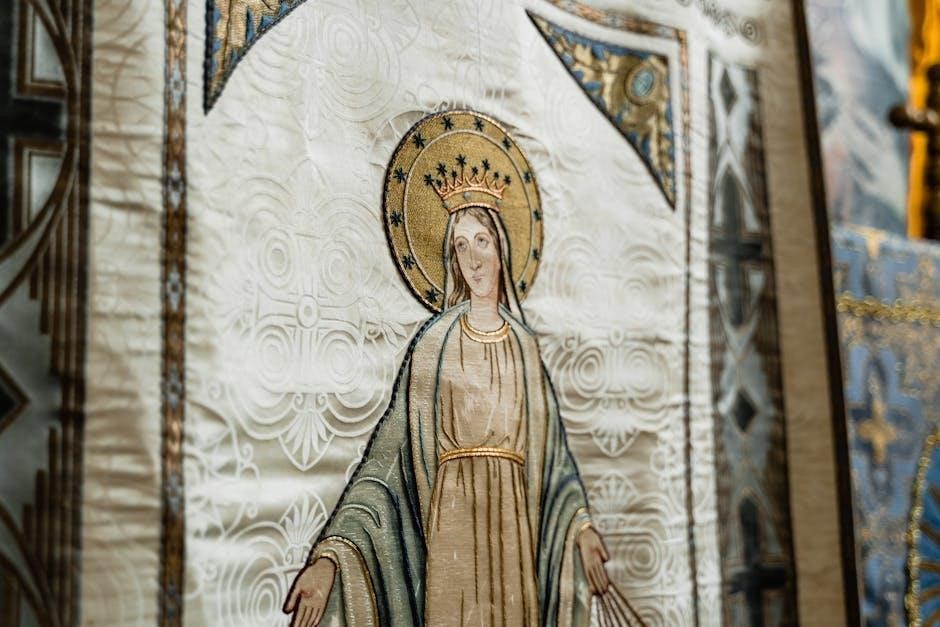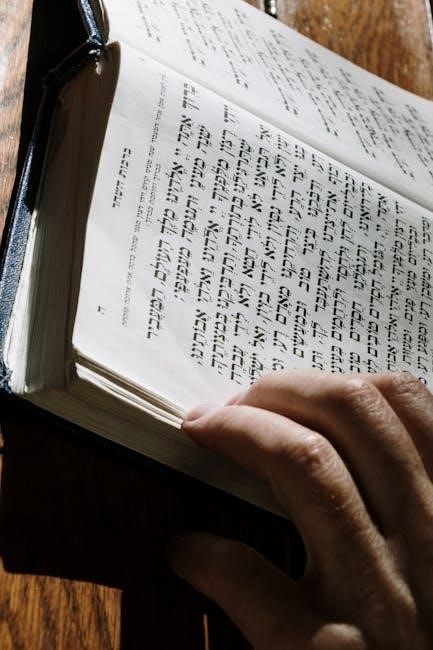The Jewish roots of the Eucharist reveal a profound connection to the Last Supper, offering insights into Jesus’ actions and words through ancient Jewish traditions.
1.1. The Importance of Exploring Jewish Roots for Christian Understanding
Exploring the Jewish roots of the Eucharist deepens Christian understanding by revealing how Jesus’ actions and teachings were shaped by Jewish scripture and tradition. This connection highlights the continuity between the Old and New Testaments, offering insights into the significance of the Last Supper and the Eucharist. By examining Jewish practices and symbols, Christians can better appreciate the rich biblical and cultural context of their faith, fostering a deeper spiritual connection to Jesus and the sacred traditions he fulfilled.
1.2. Overview of the Eucharist in Christianity and Its Connection to Judaism
The Eucharist, a central Christian sacrament, originates in the Last Supper, where Jesus transformed bread and wine into his body and blood. Rooted in Jewish tradition, it reflects the Passover Seder, commemorating the Exodus. The Eucharist bridges Christianity and Judaism, symbolizing redemption and covenant renewal. This sacred meal unites believers with Christ and each other, fulfilling Jewish messianic hopes and embodying the ultimate sacrifice, deeply intertwining Christian worship with its Jewish heritage.
The Historical Context of the Last Supper
The Last Supper occurred during a Passover Seder, a Jewish ritual commemorating the Exodus. This historical setting deeply influenced Jesus’ actions and the Eucharist’s origins.
2.1. The Last Supper as a Passover Seder
The Last Supper was a traditional Jewish Passover Seder, commemorating Israel’s liberation from Egypt. Jesus and his disciples followed customary rituals, including the sharing of wine and unleavened bread. This historical context reveals the deep Jewish roots of the Eucharist, as Jesus transformed these elements into symbols of his body and blood, fulfilling the Exodus narrative and inaugurating the New Covenant.
2.2. The Significance of the Exodus Narrative in Jewish Tradition
The Exodus narrative is a cornerstone of Jewish faith, symbolizing liberation from slavery and God’s covenant with Israel. It emphasizes divine redemption and the presence of God in history. This story, central to Passover celebrations, provided the framework for understanding Jesus’ actions during the Last Supper, linking the Eucharist to the Exodus themes of deliverance and the establishment of a new covenant.
2.3. The Role of Wine and Bread in Jewish Passover Celebrations
In Jewish Passover celebrations, wine and bread hold deep symbolic meaning. Wine represents joy, liberation, and the covenant with God, while bread, specifically unleavened matzah, signifies humility and the haste of the Exodus. These elements were central to the Seder meal, which Jesus transformed during the Last Supper, using them to institute the Eucharist, infusing them with new covenantal significance as His body and blood.

Old Testament Foundations of the Eucharist
The Eucharist finds its roots in the Old Testament through the Passover symbolism, the sacrifice of the Lamb of God, and the Bread of Presence, prefiguring Christ’s gift.
3.1. The Passover in Exodus and Its Symbolism
The Passover in Exodus recounts Israel’s deliverance from Egypt, with the lamb’s blood signifying salvation. This event foreshadows Jesus as the Lamb of God, whose sacrifice redeems humanity. The unleavened bread symbolizes haste and humility, mirroring the Eucharistic bread as Christ’s body. The Exodus narrative is central to understanding the Last Supper, where Jesus transforms the Passover meal into a sacrament of his saving presence.
3.2. The Sacrifice of the Lamb and Its Fulfillment in Jesus
The Passover lamb’s sacrifice, marking Israel’s redemption, prefigures Jesus as the Lamb of God. His death fulfills this tradition, offering salvation. The Last Supper transforms the Passover into the Eucharist, a sacrificial meal where Jesus’ body and blood are offered. This connection highlights the Eucharist’s roots in Jewish sacrifice, embodying Jesus’ role as the ultimate redemption.
3.3. The Bread of Presence and Its Connection to Divine Presence
The Bread of Presence, or Shewbread, symbolized God’s perpetual presence among Israel. Placed in the Temple, it represented ongoing communion with the Divine. Jesus, as the Bread of Life, fulfills this tradition in the Eucharist, where His real presence is experienced. This connection deepens the Eucharist’s significance, linking it to ancient Jewish worship practices and the enduring reality of divine presence among believers.
Jewish Messianic Expectations and the Eucharist
Jewish messianic hopes anticipated a new Exodus and a divine banquet. Jesus fulfilled these expectations, transforming the Passover into the Eucharist, a covenant meal of salvation.
4.1. The Jewish Hope for a New Exodus and Messiah
Jewish tradition anticipated a new Exodus, mirroring the deliverance from Egypt, led by a Messiah who would redeem Israel. This hope was deeply rooted in the Exodus narrative, which symbolized liberation and divine covenant. The Passover Seder, with its emphasis on remembrance and future redemption, reinforced this expectation. The fourth cup of wine, representing future salvation, reflected the Jewish longing for a Messiah who would usher in a new era of freedom and divine presence.
4.2. Jesus as the Messiah and the Fulfillment of Jewish Expectations
Jesus fulfilled Jewish hopes for a Messiah by embodying the redemption promised in the Exodus narrative. His actions during the Last Supper, particularly the use of bread and wine, symbolized His role as the ultimate sacrifice, transcending traditional expectations. By linking the Passover to His own body and blood, Jesus reinterpreted the Exodus, offering Himself as the true Lamb of God, thus fulfilling the Jewish longing for salvation and divine presence.
4.3. The Eucharist as a New Covenant Meal
The Eucharist is the New Covenant Meal established by Jesus during the Last Supper, transforming the Passover seder into a sacrament of His body and blood. This act fulfilled the Exodus narrative, symbolizing a new liberation through His sacrifice. It replaces the old covenant rituals, becoming the central Christian worship act, fostering unity with Jesus and among believers, and commemorating God’s new covenant with humanity through Christ.

The Eucharist in the Gospels and Early Christianity
The Gospels narrate the institution of the Eucharist during the Last Supper, symbolizing Jesus’ body and blood, central to early Christian worship and its enduring significance.
5.1. The Institution of the Eucharist in the Gospels
The Gospels narrate the institution of the Eucharist during the Last Supper, a Passover Seder, where Jesus transformed bread and wine into His body and blood. This act, recorded in Matthew, Mark, Luke, and John, symbolized the New Covenant. Jesus’ words, “This is My body” and “This cup is the new covenant in My blood,” established the Eucharist as a sacred meal, central to Christian worship and unity, fulfilling Jewish messianic expectations and sacrificial traditions.
5.2. The Symbolism of Bread and Wine in the Last Supper
The bread and wine at the Last Supper held profound symbolism, rooted in Jewish tradition. The bread, broken by Jesus, symbolized His body, soon to be broken on the cross. The wine represented His blood, shed for the forgiveness of sins, inaugurating the New Covenant. These elements drew on Passover imagery, where bread symbolized liberation and wine represented the Exodus narrative, fulfilling Jewish expectations of a messianic banquet and divine deliverance.
5.3. The Connection Between the Eucharist and Jesus’ Resurrection
The Eucharist is deeply tied to Jesus’ resurrection, as it embodies His real, life-giving presence. The risen Lord’s words, “I am with you always,” find fulfillment in the Eucharist, where believers encounter His resurrected body and blood. This sacrament not only commemorates His sacrifice but also celebrates His triumph over death, offering eternal life to all who partake, as foretold in Jewish messianic hopes and realized in Christ’s glorified state.
The Eucharist and Jewish Sacrificial Traditions
The Eucharist mirrors Jewish sacrificial traditions, particularly the Passover lamb, symbolizing redemption. Jesus’ sacrifice fulfills these rituals, offering divine presence and forgiveness through His body and blood.
6.1. The Temple Sacrifices and Their Significance
Temple sacrifices were central to Jewish worship, involving offerings like animals and grains to atone for sins and maintain covenant with God. The blood of sacrifices was crucial for forgiveness, as seen in Leviticus. These rituals were a precursor to Christ’s ultimate sacrifice, which replaced the need for repeated offerings, fulfilling the significance of Temple practices in redemption. This connection underscores the Eucharist’s roots in Jewish tradition.
6.2. Jesus as the High Priest and the Ultimate Sacrifice
Jesus is seen as the ultimate High Priest, fulfilling the role of Jewish high priests who mediated between God and humanity. His sacrifice on the cross was once-for-all, replacing the repetitive Temple offerings. As the “Lamb of God,” He took upon Himself the sins of humanity, embodying the true meaning of sacrifice. This divine act establishes the Eucharist as a commemoration of His sacrifice, uniting believers with His redeeming love.
6.3. The Eucharist as a Sacrificial Meal
The Eucharist is a sacrificial meal deeply rooted in Jewish tradition, where Christ’s once-for-all sacrifice is re-presented. It fulfills the role of ancient Temple offerings, embodying the ultimate atonement. Through the Eucharist, believers partake in Christ’s body and blood, uniting with His redeeming love and perpetuating the covenant established through His sacrifice.

The Eucharist and the Early Church
The Eucharist became a central ritual in early Christian worship, fostering unity and spiritual nourishment. It connected believers to Christ’s resurrection and continued the Jewish roots of communal worship.
7.1. The Eucharist in the Acts of the Apostles and Early Church Practice
The Eucharist is depicted in the Acts of the Apostles as a central ritual in early Christian worship, with believers gathering to break bread and share communion. This practice, rooted in the Last Supper, reflected Jewish traditions of communal meals and spiritual fellowship. The early church embraced the Eucharist as a vital expression of unity and remembrance of Christ’s sacrifice, linking it to the resurrection and the fulfillment of Jewish messianic hopes.
7.2. The Development of the Eucharist in the First Century
The Eucharist evolved in the first century as early Christians transitioned from informal gatherings to structured worship. Rooted in Jewish Passover traditions, it became a central sacrament, symbolizing communion with Christ. The apostles, as leaders, oversaw its development, ensuring fidelity to Jesus’ institution. By the end of the century, the Eucharist was firmly established as a commemoration of Christ’s sacrifice and resurrection, bridging Jewish roots with emerging Christian identity.
7.3. The Role of the Eucharist in Early Christian Worship
The Eucharist became central to early Christian worship, serving as a unifying ritual that fostered communion with Christ and among believers. Rooted in Jewish traditions, it mirrored the Last Supper, emphasizing remembrance and gratitude. Early Christians viewed it as a sacred meal that nourished both spiritually and communally, reinforcing their identity as a covenant people. This practice strengthened their faith, providing a tangible connection to Jesus’ sacrifice and resurrection.
The Eucharist and Jewish Tradition Today
The Eucharist remains deeply rooted in Jewish tradition, serving as a bridge between Judaism and Christianity, fostering dialogue and mutual understanding in contemporary religious discourse.
8.1. The Continued Relevance of Jewish Roots for Christian Worship
The Jewish roots of the Eucharist remain vital for Christian worship, offering a deeper understanding of its origins and significance. By exploring these roots, Christians can appreciate the richness of Jewish traditions that shaped the Last Supper and the Passover Seder. This connection not only enriches liturgical practices but also fosters a greater appreciation for the historical and theological bridge between Judaism and Christianity, enhancing devotion and unity in modern worship.
8.2. The Eucharist as a Bridge Between Judaism and Christianity
The Eucharist serves as a profound bridge between Judaism and Christianity, linking their shared spiritual heritage. It reflects the continuity of Jewish traditions, such as the Passover Seder, while embodying the fulfillment of messianic hopes in Jesus. This sacred meal fosters mutual understanding and respect, bridging the gap between the two faiths and highlighting their enduring connection through scripture and worship.
8.3. The Eucharist and Modern Jewish-Christian Dialogue
The Eucharist plays a vital role in modern Jewish-Christian dialogue, fostering mutual understanding and respect. By exploring its Jewish roots, Christians and Jews can deepen their appreciation for shared spiritual heritage. This dialogue highlights the Eucharist’s significance as a symbol of unity, encouraging collaboration and enriching both faith communities. It serves as a powerful reminder of the enduring connection between Judaism and Christianity, fostering a path toward greater harmony and cooperation.
The Eucharist’s Jewish roots deepen understanding of its significance, bridging Christianity and Judaism. This study invites reflection on Jesus’ teachings and the enduring power of the Eucharist.
9.1. Summarizing the Jewish Roots of the Eucharist
The Eucharist is deeply rooted in Jewish tradition, particularly the Passover Seder and the Exodus narrative. Jesus’ Last Supper, a Jewish meal, symbolized liberation and covenant renewal. The bread and wine mirrored the unleavened bread and fourth cup of Passover, signifying Jesus as the Lamb of God. Dr. Brant Pitre’s work highlights these connections, showing how the Eucharist fulfills Jewish expectations of a New Covenant meal, embodying Jesus’ divine presence and sacrifice.
9.2. The Eucharist as a Living Connection to Jesus and Judaism
The Eucharist serves as a living bridge between Christianity and Judaism, embodying the fulfillment of Jewish messianic hopes in Jesus. It reflects the divine presence and sacrifice, rooted in the Last Supper’s Passover context. Through the Eucharist, believers connect with Jesus’ life, death, and resurrection, while honoring the rich Jewish traditions that shaped his ministry. This sacred meal continues to unite faith communities, celebrating God’s covenant love and redemption.
9.3. Encouragement for Further Study and Reflection
Exploring the Jewish roots of the Eucharist invites believers to deepen their faith and appreciation for the interconnectedness of Christianity and Judaism. Readers are encouraged to study Hebrew Scriptures, Jewish traditions, and early Church writings to gain a richer understanding. Engaging in discussions, prayer, and reflection can foster a deeper connection to the Eucharist’s significance. This journey not only enriches personal devotion but also bridges interfaith dialogue and mutual respect.

